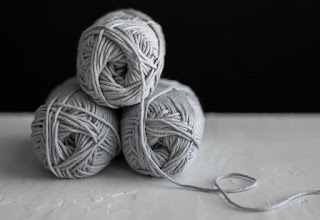Knitting a yarn over creates a small hole. This is the prerequisite for many patterns such as the popular Ajour pattern, which is very often used in knitting patterns. Yarn overs are super easy to knit. However, you have to pay attention to where the working thread lies in front of the yarn over and then wind it correctly around the right needle. Here in this blog we show you the different variants of yarn overs that are available.
Yarn overs are represented in many knitting patterns, so it is also important to master this technique and to know the important points and variants of yarn overs. Not only certain patterns, with the help of yarn over you can also knit increases, because after a yarn over you automatically always have one more stitch on the needle. Yarn over can also be used to easily work buttonholes into the knitting project.
The first variant - knit
a yarn over between a right and a purl stitch
With this variant, your
yarn over follows after a right stitch. After your yarn over, a purl stitch is
knitted. Here the working thread lies first behind the work.
Step 01: Wrap the working yarn that lies behind your
work around your right needle from back to left front to knit a purl stitch. If
you were to purl the next stitch, you would not have knitted a yarn over.
Step 02: Now wrap the working thread again from right
to left around your right knitting needle. And now you have the envelope.
Step 03: Now knit the next stitch on the left as normal.
The second variant -
knit yarn over between two right stitches
In this variant, your yarn
over follows a knit stitch. Immediately after the yarn over you also knit a
right stitch so that the yarn over lies between two right stitches. Your
working thread lies in front of the yarn over behind the work.
Step 01: Wrap the working thread that lies behind your
work around your right needle from back to left front.
Step 02: Knit the next stitch on your left knitting needle. To do this, insert the right needle into the stitch from right to left
as usual, but with the thread in front of the work.
Step 03: Wrap the working thread around your right
needle from back to front, knit the stitch as normal and let it slide off your
left needle.
You now have a knit stitch on your right needle and a yarn over in front of it. The hole under the yarn over is clearly visible.
The third variant - knit
a yarn over between a purl and a knit stitch
This variant is the
simplest. After the left stitch, the working thread is already in front of your
work. Normally you would now bring the working yarn to the back to knit a right
stitch. However, you just leave it in front of your work.
Step 01: Insert the right needle into the stitch from
right to left.
Step 02: Wrap the working yarn that is in front of your
work around your right needle.
Step 03: Now knit the stitch on your left knitting needle as usual.
Another little tip - you can easily identify errors with yarn over by the hole, either it is too small or there is no hole at all. Then you have either wrapped the working thread around the needle the wrong way round or you have made a mistake in the execution.
"Creativity is a wild mind and a disciplined eye" - Dorothy Parker
For a flawless knitting experience, we not only offer you these tips, but of course also the best knitting needles. Choose Knitpro knitting needles and get started on your next project right away.
Do You Like this Knitpro
Blog? Click here for more Knitpro Blogs like this.









%20(3).jpg)





